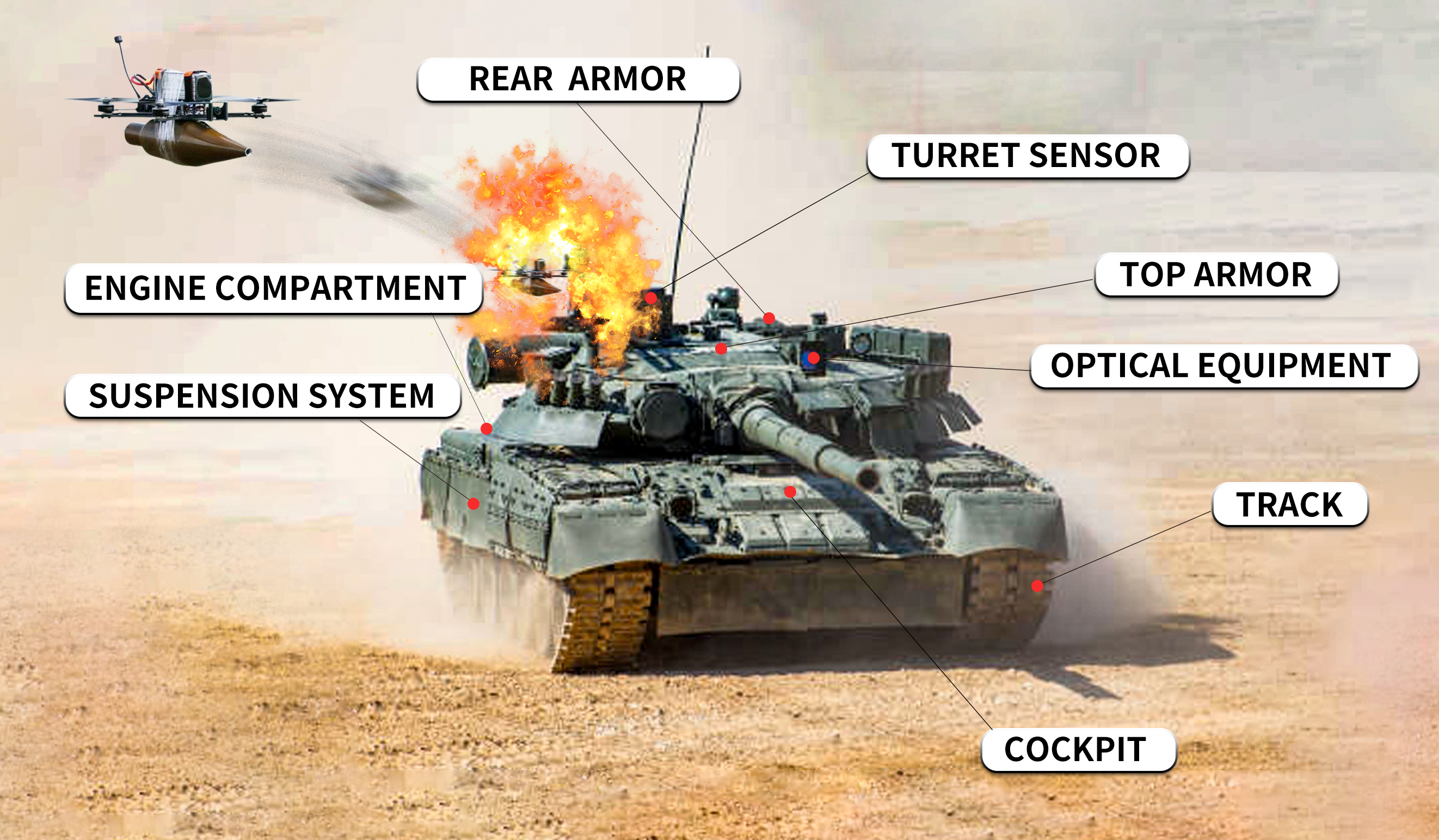2025-04-23 15:04
As a leader in SDR technology in China, AWP maintains a 100% success rate in field tests against drone threats, especially FPV.
Moreover, AWP's technology can achieve better results with minimal power and can be remotely upgraded to counter the continuously evolving anti-jamming drones.
At the same time, based on the demands of real combat, we have designed products that meet practical needs for different scenarios—vehicle-mounted, key locations, individual soldiers, and teams—so that technology can better serve real combat.
1. Vehicle-mounted : AT-625 Vehicle-mounted Four-sided Formation Equipment
Used in battlefield vehicles (tanks, armored vehicles, jeeps), outposts, and barracks.
In military conflicts, vehicles are the core of military operations and are also the most vulnerable targets.
Large vehicles, due to their size, high value, and lack of maneuverability, are more susceptible to attacks from drone swarms. With high-precision image control, FPV drones can accurately strike weak points such as the top armor, engine compartment, tracks, suspension systems, optical equipment, and turret sensors of tanks, delivering a critical blow.

Even FPVs that have lost their images can still cause significant damage to vehicles due to their immense inertia.
This is equally fatal for barracks and front line ammunition depots. The advancing battlefield requires defensive equipment that can be durable, wide-ranging, and quickly deployable.
In response to the above situations, the AT-625 was born. It uses SDR technology to effectively block the control signals, image transmission signals, and navigation signals of FPVs and UAVs, to drop enemy drones immediately within a dome of 2km. It will provide continuous protection for the convoy.
Currently, the AT-625 has been deployed to the troops.
2. Key Area Defense :AT-610 E-Wall
Applied to urban key areas, government agencies, prisons, and sports venues.
This is a unique product on the market.
When traditional signal jamming is activated, all wireless communications within the interference range will be blocked, leading to significant communication difficulties, especially in scenarios such as prisons, sports venues, government facilities, military bases, or the energy sector.
For large key areas like the energy sector and military bases, there may be a continuous attack from drone swarms, and sustained interference can affect the transmission of commands, resulting in greater danger.
Therefore, we launched the AT-610 (E-wall) which utilizes SDR technology and directional antennas to create a jamming signal that forms an electronic wall 500 meters wide, 500 meters high, and 50 meters thick. Multiple such devices can be arranged around the key area to create a hollow safe zone.

The electronic wall created by E-wall prevents UAVs and FPVs from crossing. When approaching the edge, their control, image, and navigation link systems will be directly cut off. Meanwhile, the protected targets inside the wall can communicate normally with the outside world.
3. Individual Soldier Scenario: AT-623 FPV Killer
Applied to the battlefield.
The average load for regular infantry is about 30-40 kilograms, while special forces may exceed 50 kilograms during extended missions. If an individual soldier additionally carries counter-drone equipment, such as a jammer or signal blocker, it will not only further increase the burden but may also severely impact tactical mobility.
l The Russian military "Stupor" anti-drone gun (approximately 6 kg);
l NATO Drone Gun Tactical (approximately 7.5 kg).
In addition, the penetration speed of FPV drones is extremely fast, and individual soldiers must always remain in a combat-ready state. If the countermeasure device is too large or requires two-handed operation, it will affect the soldier's combat capability against other targets.
The AT-623 FPV Killer was thus born, utilizing SDR technology. Weighing less than 1.6 kg, it can be easily lifted with one hand, and it can be activated with a single button to instantly disrupt the target FPV, with full-power interference lasting over 30 minutes.
Most impressively, it can easily cut off the FPV's video transmission and control links, and with pre-set software, it can counter 100% of the radio FPVs available on the market. Additionally, it can be remotely upgraded to combat the continuously evolving FPV systems, which is a prerequisite for its wide deployment.
4. Team Scenario :AT-619 Portable Counter-FPV/UAV Shield
Applied in urban security, prisons, battlefields, and counter-terrorism.
In battlefield teams or urban security, users can free their hands to fully combat drones; at this time, we need a more comprehensive portable anti-drone device.
As an upgraded version of the AT-623, the AT-619 can effectively disrupt the control signals, video transmission signals, and navigation signals of drones within a range greater than 1 km, rendering UAVs, FPVs, and even drone swarms ineffective.
At the same time, this device weighs less than 5.5 kg, making it easy to carry and patrol. Its non-gun appearance also prevents panic in crowds.
Therefore, if you are countering FPV and UAV in the scenarios mentioned above, the AT-619 will be your best choice.












